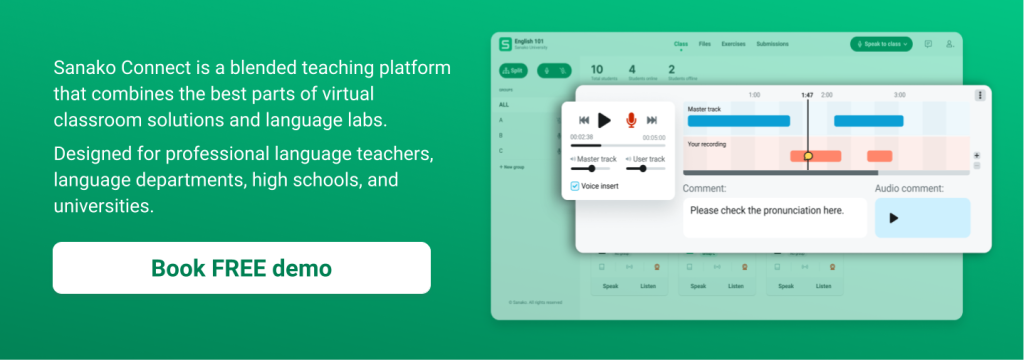Using virtual classroom software tools, like Sanako Connect, is a trend in online language teaching and learning. Virtual classroom software has the potential to bring many benefits for language teachers and for their students. In this blog post, we will take a look at the most common reasons why your school or university might gain from using a dedicated virtual classroom platform when teaching foreign languages remotely or in the physical classroom.
In a global world communication across borders is more important than ever before. Organizations from different countries are working with each other on a daily basis, people travel more and more than ever. Knowing other languages becomes a necessity for self-development and career advancement
(Read more about this from our other blog post “How investing in language education improves competitiveness“).
Virtual classroom technology is already widely used in general subject teaching. But we have recently seen a boom in online teaching platforms and virtual classroom software tools that are designed especially for language teachers.
So, how exactly does an online teaching platform benefit teachers and students in teaching and learning languages? Is it only good for students or also for teachers as well? Let’s have a look at the benefits of using online teaching solutions in language teaching!
1. Virtual classrooms enable remote teaching and distance learning (obviously!)
The first apparent benefit of virtual classrooms for language learning is that they enable remote access, which means teachers can easily set up virtual classes for real-time teaching or alternatively deliver content and students can access it anywhere at their own pace. The 2020-2021 Coronavirus pandemic made this extremely urgent and important for schools and universities across the globe.
Nevertheless, this is an important benefit regardless of the pandemia – flexibility and being able to attend classes remotely is a valuable feature for modern teachers and students.
People are no longer bound by traditional physical classroom environments nor time constraints inside a learning session. Whether you live far from school, being a night owl when night time is the most effective hours, all of those can be solved with online teaching platforms.
2. Virtual classrooms are a new and inspiring method of teaching and learning
It has been proven that the use of a mix of different media rather than mere textbooks increases teaching efficiency and learning retention. Most online teaching platforms these days support multimedia content, some even incorporate interactive tasks and gamification. Students can have a unique learning experience since they can learn while playing or interact with different kinds of multimedia content instead of just text-based content.
Furthermore, with this approach, students can gain more knowledge about the culture, history, and other knowledge relating to the countries that speak the target language. This not only excites students but also teachers as well when they have the freedom to be creative when designing a language lesson. Modern virtual classroom software can therefore improve students’ motivation to learn by being more enjoyable and inspiring than traditional teaching/learning methods.
(Read also our blog post about different ways how to improve student motivation when teaching online.)
3. Virtual classrooms help to optimise teachers’ time
Virtual classroom software and online teaching in general offers a way to reach more students while providing richer content for learning, especially for learning languages. Surely it saves financial resources for schools but at the same time it saves time for teachers as well.
Once creating language learning content, teachers can easily copy or update it later, keeping the teaching materials up-to-date. Current virtual classroom technologies even enable the automatic generation of exercises so that teachers don’t need to start from scratch. Sometimes this saves hours of work time per week. Moreover, many online teaching platforms support evaluating and tracking students’ work automatically, providing ease in managing and monitoring student progress.
For students, saving travel time is one matter, learning languages more efficiently is another. For instance, in a traditional language classroom setting, one can be easily distracted by others when working in pairs for speaking exercises. With modern online classroom technologies involved, they can no longer be bothered by other groups but focusing on their pair work and even better, listen back to themselves later to know what they can improve in terms of pronunciation for example. Simultaneously, teachers can provide timely support and feedback to students whenever they need it through online chat or audio, and even listen in to their practice to help them improve faster!
4. In a virtual classroom environment even shy students can practice languages with confidence
Practice makes perfect. That holds particularly true especially in learning languages. Nonetheless, have you ever seen students hesitant to volunteer to read out loud inside a class or speak too quietly and shyly since they think they are “not that good”? Online teaching platforms could solve this problem. No more pressure and fear of public embarrassment. Students would be more encouraged to practice pronunciation and speaking more than ever with the help of virtual classroom tools.
Are you a language teacher looking for a dedicated virtual classroom software for language teachers? Contact us for your FREE demo to see how Sanako’s virtual classroom tool for language teachers could help you.

